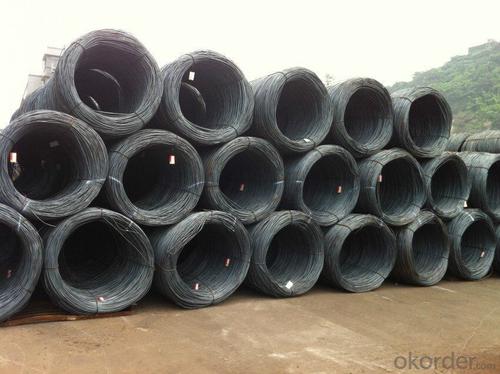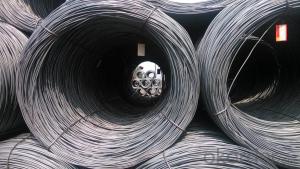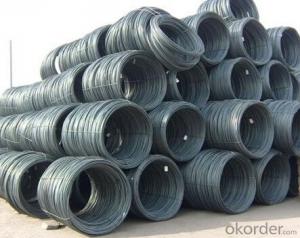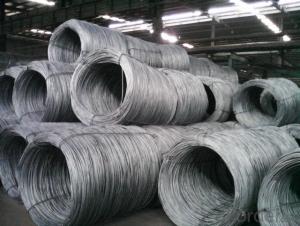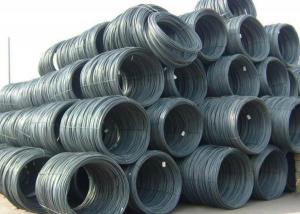Supply 6.5mm steel wire rod in coils with grade A quality
- Loading Port:
- Tianjin
- Payment Terms:
- TT OR LC
- Min Order Qty:
- 25 m.t.
- Supply Capability:
- 500000 m.t./month
OKorder Service Pledge
OKorder Financial Service
You Might Also Like
Specification
Steel Grade: Q195/235, SAE1006-1018B Standard: ASTM, GB
Diameter: 5.5mm, 6.5mm, 7mm,8mm,9mm,10mm,12mm,14mm
Type: Drawn Wire Alloy or Not: Alloy Brand Name: HSKY
Technique: Hot Rolled Place of Origin: China Mainland
Chemical Composition:(Please kindly find our chemistry of our material based on SAE1006B and SAE1008B as below for your information)
High carbon/Low carbon/common carbon Steel wire rod | With boron for rebate tax |
Grade | SAE1006B SAE1008B SAE1018B |
Package | In coil ,in bundle, |
Coil weight | about 2000kg-3000kgs |
Size: | 5.5mm 6.5mm 8mm 10mm 12mm 14mm 16mm |
Types | High Carbon ,Low carbon ,Common carbon |
Exported Country | South Korea,Vietnam,Indonesia,Myanmar,Philippines and Afrca,Ect |
Delivery term: | within 30 days after receive the LC |
Payment Term: | LC at sight ,LC 30-120 days after B/L date, TT payment |
The Standard of Physical Properties:
Grade | Chemical Composition(%) | |||||
C | Mn | Si | S | P | Cr | |
SAE1006 | 0.03~O.07 | ≤0.32 | ≤0.30 | ≤0.045 | ≤0.040 | >0.30 |
Mechanical properties | ||||||
Yield strength(N/mm2) | Tensile strength(N/mm2) | Elongation(%) | ||||
250-280 | 350-380 | ≥32 | ||||
Grade | Chemical Composition(%) | |||||
C | Mn | Si | S | P | Cr | |
SAE1008 | 0.10max | 0.3~O.50 | 0.15max | 0.050max | 0.040 max | 0.30 min |
Mechanical properties | ||||||
Yield strength(N/mm2) | Tensile strength(N/mm2) | Elongation(%) | ||||
≥195 | 315-430 | ≥30 | ||||
Usage and Applications of Steel Wire Rod in Coil:
After hot-rolled the products shaped into coil and delivery as finished product, including round, square, rectangular, hexagonal and so on, Since most of the products are round, it is generally called wire rod. Steel wire rod is widely used in construction and manufacturing. Steel wire rod is mainly used for reinforcement of reinforced concrete and welded structure or reprocessed (roberts, nail etc) materials, especially used to produce wire drawing, welding electrode, nails,spring, electronic, precise machinery parts and so on.
Packaging & Delivery of Steel Wire Rod in Coil:
Packaging Detail: products are packed in coil and then shipped by container or bulk vessel
Each coil weight: 2-3MT
Delivery Detail: within 45 days after received deposit or LC.
Label: to be specified by customer, generally, each bundle has 1-2 labels
Trade terms: CFR, CIF
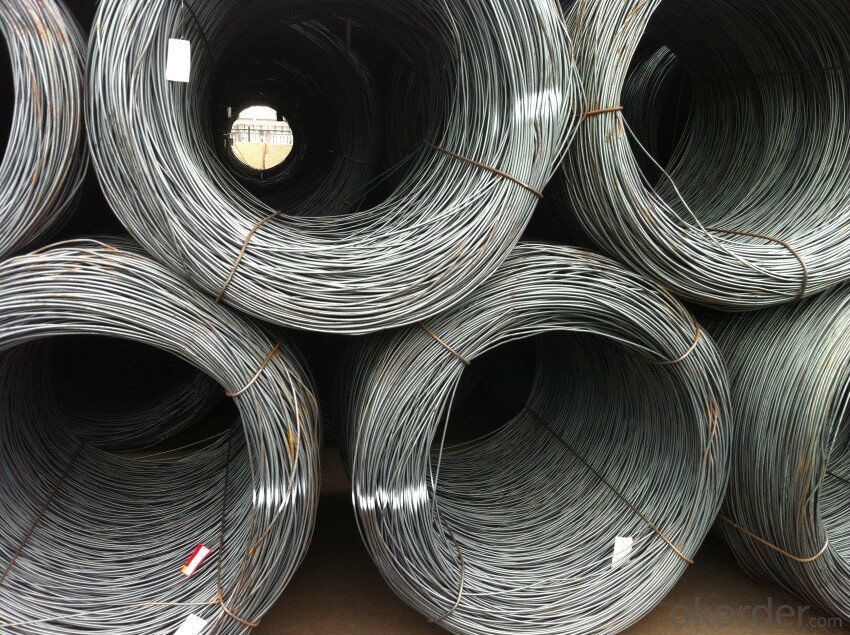
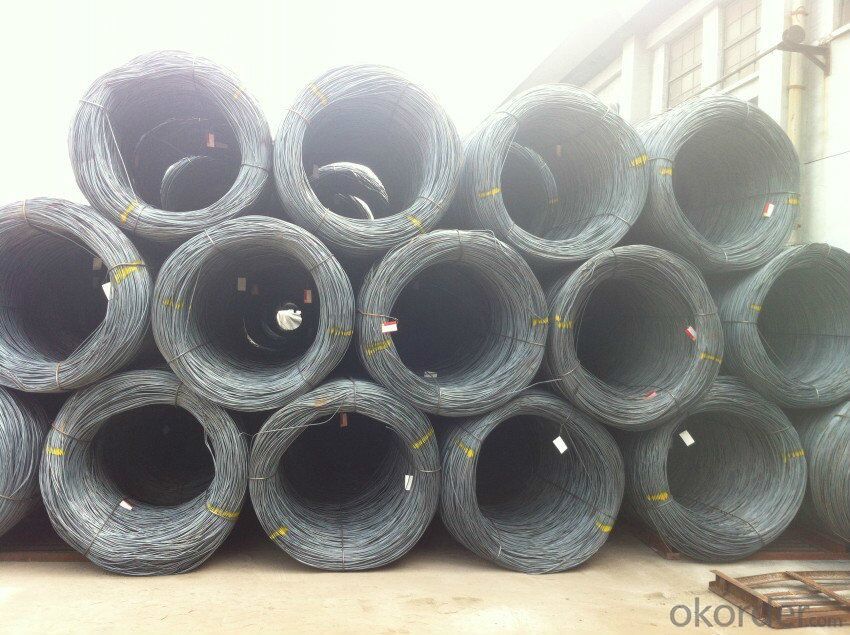
- Q: How are steel wire rods used in the manufacturing of tire reinforcements?
- Steel wire rods are used in the manufacturing of tire reinforcements by being embedded in rubber to enhance the strength, durability, and stability of tires. These rods provide structural support and help to resist deformation, improve traction, and increase the overall performance and safety of tires.
- Q: What are the advantages of using steel wire rod over other materials?
- There are several advantages of using steel wire rod over other materials. Firstly, steel wire rod offers high strength and durability, making it suitable for various applications where strength is crucial, such as construction, automotive, and manufacturing industries. Secondly, steel wire rod has excellent flexibility, allowing it to be easily bent and shaped without losing its strength, which makes it ideal for applications that require flexibility, like cable wires or springs. Additionally, steel wire rod has good corrosion resistance, ensuring its longevity even in harsh environments. Its availability in different grades and sizes further enhances its versatility. Overall, the superior strength, flexibility, and corrosion resistance of steel wire rod make it a preferred choice for numerous applications.
- Q: What are the different types of steel wire rod surface defects and their impact on product safety?
- There are several types of steel wire rod surface defects that can impact product safety. These defects include surface cracks, pits, scratches, and scale. Surface cracks can weaken the wire rod, leading to potential failures and safety hazards. Pits and scratches can create stress concentration points, which can also compromise the strength and integrity of the wire. Scale, which is a thin layer of oxide formed on the surface, can reduce the corrosion resistance and mechanical properties of the wire rod, making it more susceptible to failure. It is essential to identify and address these defects to ensure the safety and reliability of the final products made from steel wire rods.
- Q: How is steel wire rod used in the manufacturing of wire for musical instruments?
- Steel wire rod is used in the manufacturing of wire for musical instruments as it serves as the primary material for creating the strings. The wire rod is first processed and drawn into thinner gauges to achieve the desired thickness and flexibility required for each specific instrument. These wires are then further treated, coated, or wound with various materials to enhance their tonal qualities and durability. Overall, steel wire rod is an essential component in producing high-quality strings that contribute to the sound and performance of musical instruments.
- Q: What are the common production processes for chromium-coated steel wire rod?
- The common production processes for chromium-coated steel wire rod include surface preparation, electroplating, and finishing. The surface preparation involves cleaning and degreasing the steel wire rod to ensure a smooth and clean surface. Electroplating is then performed, where the wire rod is immersed in a chromium plating bath and an electric current is passed through it, causing chromium to deposit onto the surface. Finally, the wire rod goes through a finishing process, which may include polishing, buffing, or additional coatings to enhance the appearance and durability of the chromium-coated steel wire rod.
- Q: How is steel wire rod used in the manufacturing of wire for seismic reinforcement in buildings?
- Steel wire rod is an essential component in the manufacturing of wire for seismic reinforcement in buildings. It is used as the primary raw material for producing high-strength and durable wire, which is then incorporated into the structural framework of buildings. The steel wire rod undergoes various processes, including drawing, annealing, and galvanizing, to enhance its strength, flexibility, and corrosion resistance. The resulting wire is then embedded within the concrete elements of a building to enhance its ability to withstand seismic forces and ensure structural integrity during earthquakes.
- Q: How is steel wire rod used in the production of wire mesh partitions?
- Wire mesh partitions rely heavily on steel wire rod, which is essential for their production. These partitions find widespread use in industrial warehouses, commercial spaces, and even residential areas. The raw material for manufacturing the wire mesh used in these partitions is steel wire rod. This wire rod is typically made of high-quality steel, ensuring durability, strength, and resistance to corrosion. These properties play a crucial role in guaranteeing the long-lasting and reliable nature of the wire mesh partitions. To manufacture wire mesh partitions, the steel wire rod goes through a series of manufacturing processes. Initially, the wire rod is drawn through dies to decrease its diameter and increase its length. This process, known as wire drawing, results in a thinner and longer wire that is more suitable for weaving. Following the wire drawing process, the wire is woven into a mesh pattern using a specialized machine. Depending on the desired characteristics of the wire mesh partition, the weaving process can be done in various patterns such as plain weave, twill weave, or Dutch weave. This interlocking process creates a strong and stable mesh structure. After the wire mesh is woven, it may undergo additional processes such as galvanization or coating to enhance its resistance to corrosion or provide a specific finish. Galvanization involves applying a layer of zinc to the wire mesh, which acts as a protective barrier against rust and other environmental factors. Once the wire mesh is prepared, it is cut, shaped, and assembled to form the partitions. The wire mesh is securely attached to a frame made of metal or other materials, resulting in a sturdy and secure partition system. These partitions can be customized to fit specific spaces and requirements, offering efficient storage, security, and separation of areas. To summarize, steel wire rod plays a vital role in the production of wire mesh partitions. It serves as the raw material and provides the necessary strength, durability, and resistance to corrosion. Through various manufacturing processes, the steel wire rod is transformed into a woven mesh pattern, which is then shaped and assembled into wire mesh partitions for a wide range of applications.
- Q: What are the safety requirements for steel wire rod used in elevator wire ropes?
- Ensuring the reliable and secure operation of elevators requires strict adherence to safety requirements for steel wire rod used in elevator wire ropes. These requirements, established by industry standards and regulations, guarantee the strength, durability, and performance of the wire ropes. Key safety requirements for steel wire rod in elevator wire ropes include: 1. Material Quality: Elevator wire ropes must use steel wire rod that meets specific material standards, typically set by organizations like ASTM. These standards define the chemical composition, mechanical properties, and other characteristics of the steel, ensuring it can withstand the necessary loads and stresses. 2. Strength: Elevator wire ropes experience significant loads and stresses during operation, so the steel wire rod must possess high tensile strength to withstand these forces without breaking. Industry standards establish minimum tensile strength requirements to ensure passenger safety and the reliability of the elevator system. 3. Fatigue Resistance: Due to repeated bending and flexing, elevator wire ropes are prone to fatigue failure if the steel wire rod lacks proper resistance. The steel wire rod should exhibit excellent fatigue resistance properties, enabling the wire rope to endure millions of cycles without degradation. 4. Surface Quality: The surface of the steel wire rod must be smooth and defect-free to avoid weakening the wire rope. Surface irregularities like pits, scratches, or deformations can act as stress concentration points, reducing the overall strength and safety of the wire rope. 5. Dimensional Accuracy: Proper fit and functionality require the steel wire rod to meet specific dimensional tolerances, including diameter, roundness, and straightness. These tolerances are vital for the correct assembly and operation of the wire ropes. 6. Testing and Certification: Manufacturers of steel wire rod for elevator wire ropes should conduct rigorous testing to ensure compliance with safety requirements. These tests may cover tensile strength, fatigue, surface inspection, and dimensional measurements. Certification from recognized bodies or compliance with industry standards like ISO 9001 further guarantees the quality and safety of the steel wire rod. By adhering to these safety requirements, elevator manufacturers and operators can have confidence in the reliability and performance of their wire ropes, ultimately ensuring passenger safety and the smooth functioning of elevator systems.
- Q: What are the main factors affecting the strength of steel wire rod?
- The main factors affecting the strength of steel wire rod include the composition of the steel, the manufacturing process, and the heat treatment applied to the wire rod.
- Q: How does the quality of steel wire rod affect the performance of wire products?
- The quality of steel wire rod plays a crucial role in determining the performance of wire products. Firstly, the strength and durability of wire products are directly influenced by the quality of the steel wire rod. High-quality steel wire rods are made from superior materials and have undergone stringent manufacturing processes, resulting in enhanced tensile strength and resistance to deformation. This ensures that wire products can withstand heavy loads, tension, and stress without breaking or losing shape. On the other hand, low-quality steel wire rods are more prone to breakage, stretching, or bending under similar conditions, leading to compromised performance and potentially hazardous situations. Secondly, the surface finish of the wire rod impacts the overall performance of wire products. A smooth and uniform surface finish, achieved through precise manufacturing techniques, reduces friction and abrasion during the use of wire products. This not only enhances their lifespan but also improves their functionality. In contrast, wire rods with poor surface finish may have rough or uneven surfaces, resulting in increased friction and wear. This can lead to premature degradation, decreased performance, and potential safety hazards. Furthermore, the chemical composition of the steel wire rod affects the corrosion resistance of wire products. High-quality wire rods are typically made from corrosion-resistant materials or have protective coatings, preventing rust or corrosion over time. This is particularly important for wire products used in outdoor or moist environments where exposure to water, humidity, or chemicals may occur. Wire products made from low-quality wire rods with inadequate corrosion resistance can deteriorate faster, leading to decreased performance, structural weakness, and potential failure. In summary, the quality of steel wire rod directly impacts the performance of wire products. Higher quality wire rods result in stronger, more durable, and longer-lasting wire products with enhanced resistance to deformation, improved surface finish, and better corrosion resistance. Investing in high-quality steel wire rods ensures the production of wire products that meet performance standards, provide reliable functionality, and ensure user safety.
Send your message to us
Supply 6.5mm steel wire rod in coils with grade A quality
- Loading Port:
- Tianjin
- Payment Terms:
- TT OR LC
- Min Order Qty:
- 25 m.t.
- Supply Capability:
- 500000 m.t./month
OKorder Service Pledge
OKorder Financial Service
Similar products
Hot products
Hot Searches
Related keywords



